
How PandaDoc Pivoted Its Business Model in 24 Hours
Businesses are constantly adapting to internal and external events to remain competitive and deliver what their customers need. This is a normal and constant process, and it usually happens gradually over a long period of time with pricing changes, new product launches, market repositionings, and expansion. But once in a while, an extraordinary event like COVID-19 makes a business jam-pack major changes into a very tight schedule. That's what this story is about.
On March 17, 2020, PandaDoc launched a completely free, unlimited eSignature offering called Free eSign to help small- and medium-sized businesses (SMBs) keep moving forward in an environment where they suddenly couldn’t meet customers and conduct business as they did before. We were able to do this within 24 hours — quite a change for a company in the B2B space. Here’s how we made it happen so quickly.

Decision
We’d always considered making eSignature a free offering for our customers. Our co-founder and CEO, Mikita Mikado, was a big proponent of this and saw eSignature as an essential and commoditizing space. After all, PandaDoc’s value proposition is to automate all areas of a user’s document workflow, not just the eSignature piece.
We conducted research to help us understand how the launch of a truly free product would impact our business. And when I say “truly free,“ I mean it. We didn’t want to launch a free plan with ridiculous limitations a user would hit within a week because they were using the product so frequently. And we didn’t want to launch it as bait to lure. As we built Free eSign, we wanted to keep the main core elements of our paid solution intact: unlimited documents, unlimited users.
While our research helped us understand the potential impact to our revenue and internal processes (sales-led vs. self-service funnels), it didn’t provide a clear picture of what would happen in reality. And whenever there’s not enough certainty and urgency, businesses tend to put decisions like this on hold. That is, until a massive push appears out of nowhere…
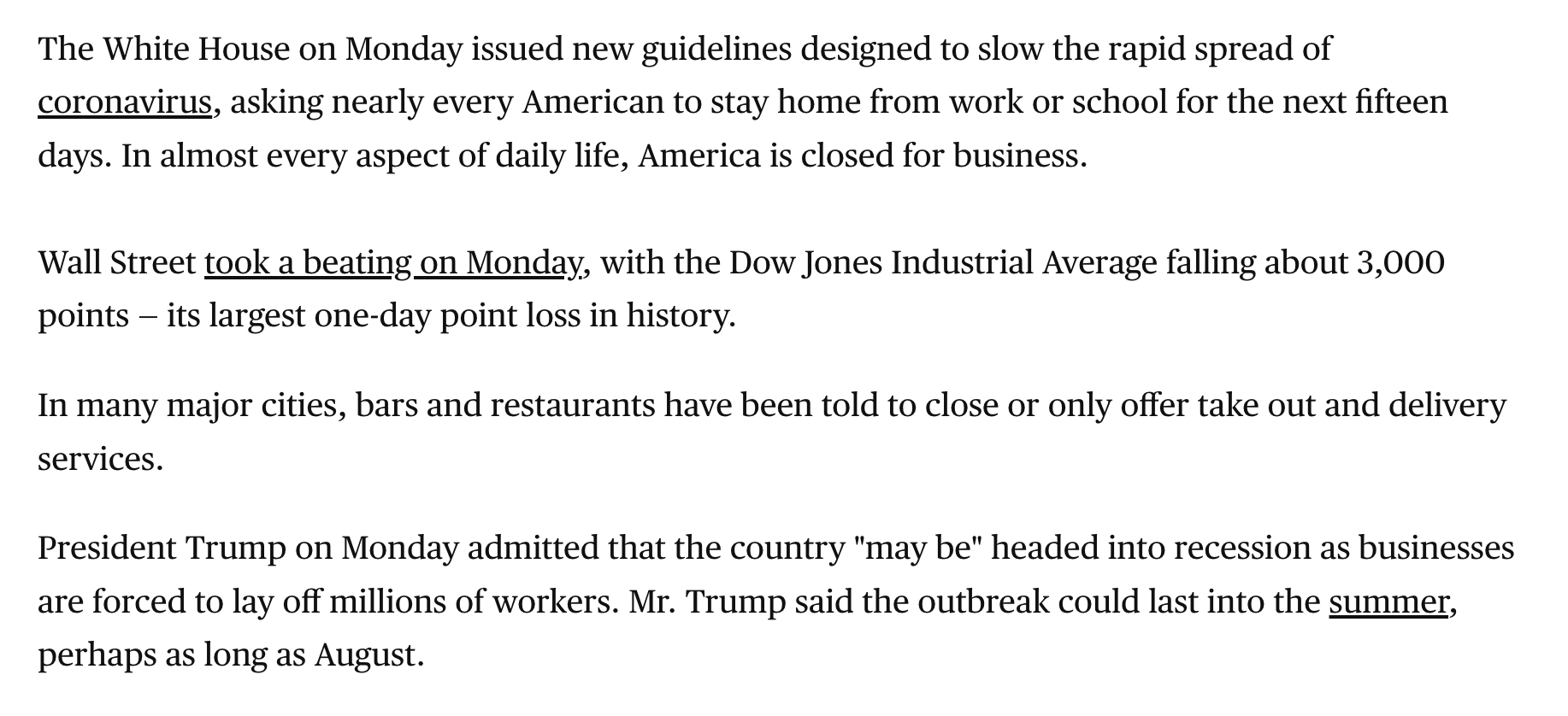
Although it was unclear at the time how coronavirus would unfold (little did we know!), it was apparent that this was something significant — and that our business needed to react. This external push returned our previous discussion about a free offering to the forefront, and this time its goals weren’t simply internal in terms of our business model. We were also thinking externally about helping SMBs survive.
And so, on the evening of March 16, we held an executive meeting and made the decision to launch a free offering as our swift reaction to COVID-19.
Communication
If a significant change affects multiple parts of a business, it requires transparent communication. And if you don’t want to deal with the consequences of the change more than the change itself, make sure you have a clear communication plan, as well as reinforcement from multiple levels in the organization.
In our particular situation, we knew we needed to communicate our new free offering to all our customer-facing functions — namely, our sales, customer success, and customer support teams. So once the decision was made, we posted a company-wide announcement within Slack.

As you’d imagine, we received a number of questions and requests for clarification. We soon followed up with additional communication, describing the initiative in greater detail.
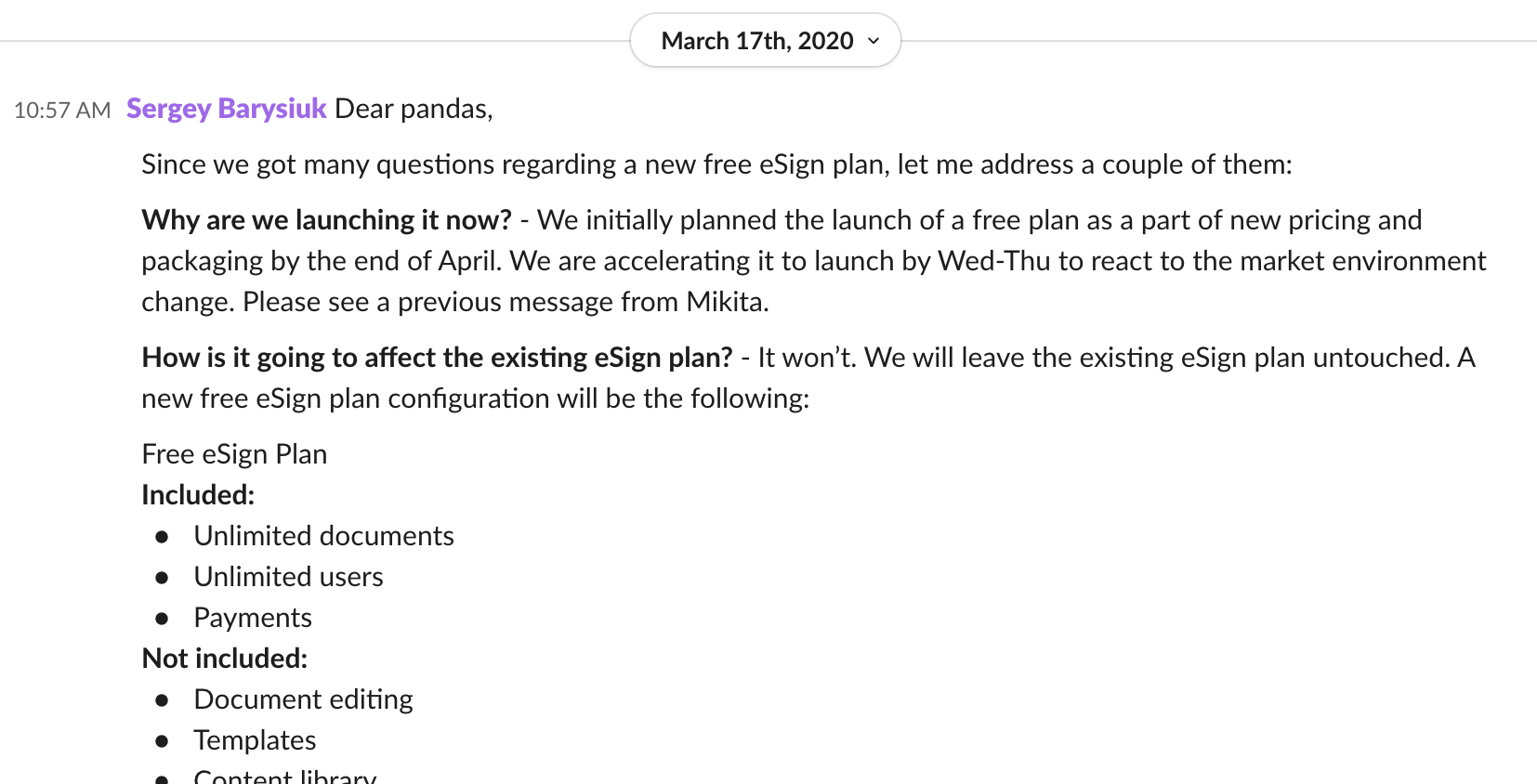
We felt it was crucial to close the feedback loop with a decision-maker, so I became the single point of contact for all questions regarding this project. While it certainly isn’t scalable under normal circumstances, decision-making speed matters most in a moment like we faced in March 2020.
We also created a dedicated Slack channel where we could easily share updates and collaborate.


Resourcing
With an ambitious project like Free eSign’s sudden launch, the right team is the key to success. You need to make sure you have people onboard who can cover all aspects independently. It’s best to keep the team small and nimble enough to avoid lots of coordination, but large enough that the group won’t struggle with implementation and a lack of resources.
We approached the project as a hackathon and assembled our team on the fly.

We had three major areas to address:
- Product: Signup and onboarding, product offering and functionality, and plan/billing changes
- Website: Pricing page changes and other important updates
- Business Operations: Making sure Free eSign wouldn’t break our reporting, while properly displaying in our reports and flowing smoothly to external systems
Each of these areas was covered by specially assembled teams from product growth, marketing, engineering, and business operations.
Collaboration
Most of the coordination occurred in the aforementioned Slack channel, and people worked at a rapid pace in a hackathon-like environment. Leaders of each area became decision-makers, worked directly with their teams, and reported major updates within the channel.

While our product and engineering teams were gearing up for the release and connecting all the parts, our customer-facing and marketing teams also started preparing for the launch.
For our customer success team, it was important to equip our agents with the right answers to give our customers. We typically prepare support documents before any product updates and new features go live, and this time was certainly no exception. Our team documented differences between plans, what would (and wouldn’t) be available with Free eSign, and other details to share with our customers.
To properly launch Free eSign and broadcast the message behind our initiative, our marketing team needed to do a lot of work as well. We had a team working on blog posts and social media announcements that would amplify Free eSign’s impact. Like in a hackathon, the idea and its execution is important, but how you pitch it at the end can magnify all your efforts.


Launch
18 hours after our initial decision, we were ready to push the button and open Free eSign to the public. All the changes were rolled out in the application, and all we needed to do was update our website to reveal our brand-new offering.
The air — or more accurately, Slack — was full of the energy associated with going from zero to full release so quickly. This was no prototype we were giving our customers. This was something entirely fresh.
And so, once the last polishing touches were made, we published an updated pricing page that included our new Free eSign plan. Our freshly written blog and social media posts went live immediately afterward.
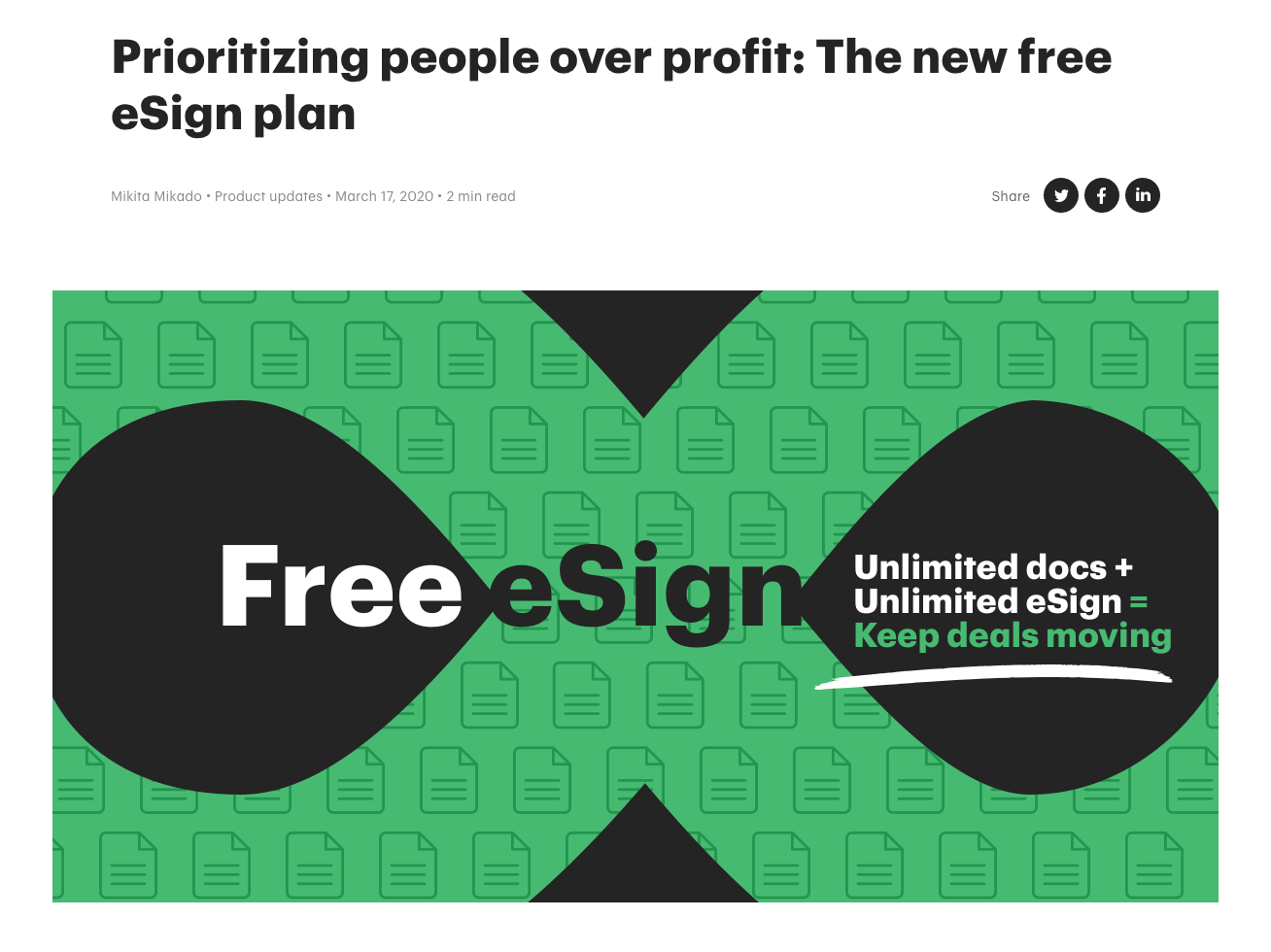
And literally minutes later, we started seeing customers signing up…
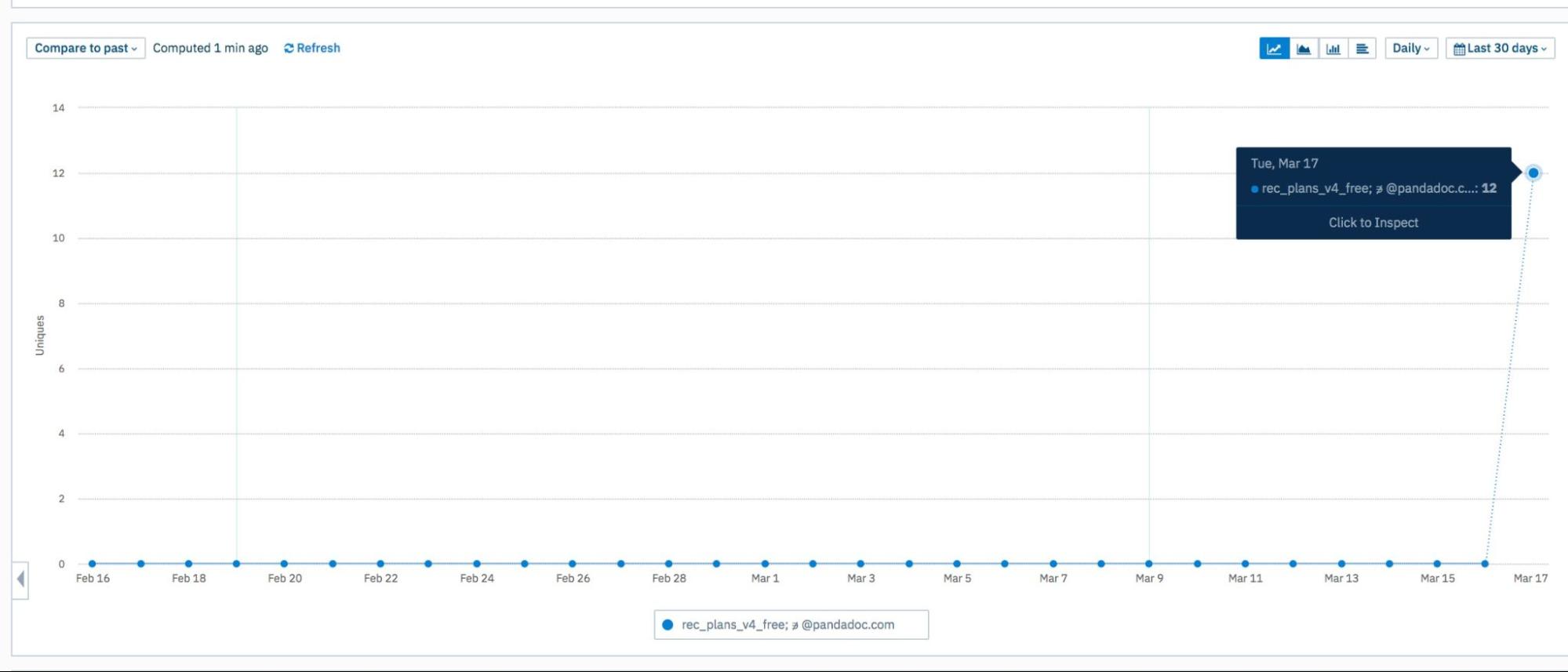
Post-launch
Once Free eSign was live, we knew we had a few items to return to — things we’d intentionally left untouched so we could prioritize speed over perfection. This work found its way into our normal development cycle and was addressed in current and future sprints.
We invested further in data analytics to start tracking how Free eSign was impacting our business. This included cohort analyses of all our plans, plus deep analysis of all customers signing up for the new offering and how, on a high level, they used our app. Within a very short time, our completely free, unlimited offering became part of our normal business operations.
Looking back now, two and a half years later, those 18 hours made a tremendous impact on PandaDoc’s business and growth trajectory. At the time of Free eSign’s first anniversary in March 2021, we did an in-depth review and learned that over one million documents had been sent via Free eSign and we’d gotten over 200,000 signups. (Further details are available in our anniversary blog post.)
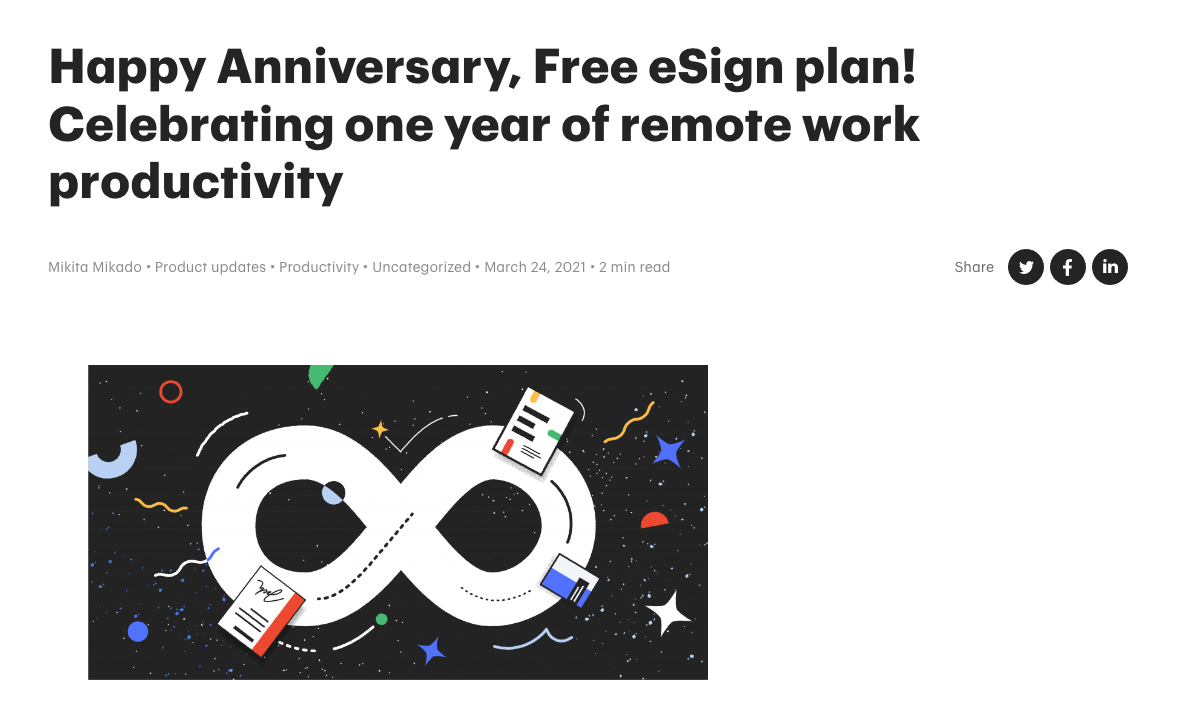
Summary
At PandaDoc, we see our whole organization’s agility as one of our competitive advantages. Growth-stage companies need to experiment and test new ideas to uncover opportunities for expansion, and quick decision-making and swift execution both play crucial roles.
As your company grows, keep these suggestions in mind:
- Many decisions are “two-way doors.” If you feel like you don’t have enough data, treat it as an experiment and apply clear success criteria. If you don’t meet this criteria, you can always roll it back.
- Go the extra mile to communicate your decision properly, especially if your decision may add uncertainty to different areas of your business.
- Assemble a fully autonomous team with clear ownership structure. Keep it as small as possible, but give them enough power to execute.
- Don’t overlook the announcement part, both internally and externally. At the end of the day, you need to celebrate your win.

How to run a successful multi-team sprint review
A sprint review is an ideal way to show all the hard work and accomplishments of a team at the end of a sprint. Based around transparency, it shows work that’s completed or unfinished, plus projects that have been added and removed from the sprint. One of the most valuable parts of this informal meeting is feedback from participants, as it’s often better understood verbally.
.png)
What are PandaDoc Offsites and their purpose?
If you had a chance to check out the first issue of Bam-Boo magazine, you already know that PandaDoc is a remote-first company. All Pandas are free to choose where to work and, most of the time, how to plan their work day.
-min.png)
Building Agility on Scale
At the fast-growing stage, any company starts facing the problem of scaling. In this article, we’d like to share how we manage scaling while staying adaptive to the market changes and suggest experiments to implement in your company (check the “try/avoid” sections).
